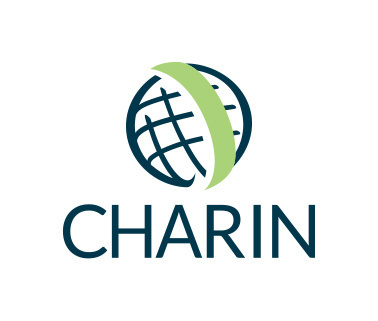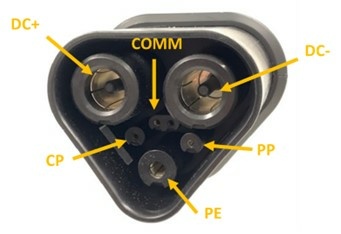
You may have seen the recent CharIN whitepaper, Megawatt Charging System (MCS): Recommendations and requirements for MCS related standards bodies and solution suppliers, and want to better understand how MCS might impact your business. The Megawatt Charging System is a new standard that builds upon industry experiences with the Combined Charging System (CCS) and uses state-of-the-art technology to provide reliable, high power energy transfer needed for large commercial electric transportation, including marine, aviation, and other off-road applications, for charging power up to 4.5 MW!
To enable the higher-powered charging, MCS includes unique additional features such as the connector shape, communication electronics, increased current capacity, increased voltage level, and no moving parts on the connector.

Source: CharIN e. V. MCS Subgroup, 2022
MCS has been developed by many participating businesses, universities, utilities, and laboratories, with a clear focus to provide a superior charging solution needed for global commercial applications – critical for the expansion of transportation electrification.
CharIN’s whitepaper provided detailed specifications and recommendations for MCS and is intended to support the global standards bodies who will release the final MCS standards, which will ultimately be used by companies, international communities, and governments to ensure interoperability of charging equipment and vehicles. Demand for MCS is moving ahead quickly. The HoLa project in Europe has already committed to deploying four charging locations using MCS, with over 750 kW charging capability by 2024 as a first step. The standards are set to be published between 2024 and 2025 in ISO, IEC, and SAE with up to 4.5 MW.
While the whitepaper covers many technical and non-technical aspects of the MCS, it does not include recommendations for a smooth operational transition from CCS to MCS. CharIN believes there are opportunities to upgrade or retrofit a CCS charger if a site or equipment is prepared in advance for MCS. Given the massive amount of investment required to support the burgeoning EV industry, this article was developed to further the discussion of what a CCS to MCS transition may look like.
How Companies are Managing the CCS to MCS Transition
CharIN views MCS demand as highly dependent on new use cases and vehicle applications. We anticipate a need to operate both CCS and MCS simultaneously, at least for truck applications, for many years to come. For example, the European Automobile Manufacturers’ Association (ACEA) has developed an interactive map to identify optimal regional charging locations throughout Europe. Based on forecasted battery electric truck demand, a minimum of 40,000 to 50,000 high-power chargers (above 500kW) are anticipated to be required by 2030. Maps like these make it easier to estimate how MCS installations could be deployed for use by fleets.
With the release of MCS in the near term, many companies that are planning, purchasing, and installing commercial EV charging equipment may be wondering how to handle this transition. Because CCS and MCS are not directly compatible, it may be unclear how companies should manage the immediate needs of fleet electrification and the long-term plans to continue adding charging capabilities with MCS.
According to Salim Youssefzadeh, CEO of WattEV, a company building out public truck charging sites, the company is preparing sites today with multiple CCS ports, with the plan to aggregate the power modules of the CCS chargers to eventually power the MCS ports. Specifically, the power cabinets will have flexibility in the "building block" power modules to be able to provide power to a CCS charging pedestal and combine multiple modules together to provide higher charging power to an MCS pedestal. Once MCS charging pedestals are available, they can be added to a site, and utilize the power cabinets which already provide power to the CCS chargers. Youssefzadeh stated, “With a focus on heavy duty transport at WattEV, it was imperative for us to find a solution that supports both CCS and MCS so our investment will not become obsolete during the transition. Starting in 2023, all our installations will use modules of 1200kW systems that support 5 CCS at 240kW or one MCS at 1200kW."
Daimler Truck North America, a truck OEM, is taking the logical route of having both MCS and CCS charging ports on their trucks or providing a retrofit option to customers. In a statement provided by Nathan Hill, Head of ZEV Infrastructure and Consulting, “Both CCS and MCS will play important roles in the transition to commercial Zero Emission Vehicles. It will be crucial that vehicle OEMs and charging station designers have a strategy for dual-compatibility or an option to retrofit as the prevalence shifts from CCS to MCS over the next decade or so.”
Starting with the Basics – Utility Interconnections
It remains critically important, independent of specific vehicle needs regarding CCS or MCS, that fleets should start planning with their local utility for electrical service connections and upgrades. While small fleets may not need major upgrades to support their immediate electrification needs, that may not be the case for large fleets. Especially with fleets that need large electric installations, the timelines for these projects can be very long (i.e., 2 to 5 years). Getting power to a specific location is the most important part of a charging location planning, and that power connection can be used for MCS just the same as it can for CCS.
One of the first public truck charging sites, Electric Island in Portland Oregon, was a partnership between Portland General Electric (PGE), the local power utility, and Daimler Trucks North America. Even with PGE covering 50% of costs and deeply involved in the planning, design, and construction of the site, the utility connection took over a year to complete. The site design was focused on future expansion and flexibility, so MCS chargers and stationary storage can be easily added at a later date.
Black & Veatch, a global engineering, consulting and construction firm, has a decade of experience designing high power charging sites that are expandable, such as Electric Island. “As we enter the megawatt charging era, anticipating vehicle fleet requirements and aligning equipment layouts, clean energy supply and configuration optionality will be key”, said Paul Stith, Associate Vice President of Global Transportation Initiatives. “As industrial loads, these sites will often have long schedules to bring power, provide resilience and distributed generation where and when it makes sense. Navigating the mixture of CCS and MCS over time will be one factor among many integrated into site and network scaling plans.”
Becoming well-acquainted with the local power utility should be high on any fleet’s list of important steps to take. The local utility will go from useful business contact to strategic partner, providing the fuel for day-to-day operations.
CCS Infrastructure Won’t Become Obsolete
As sites come online, CCS will be used in the immediate term, and MCS will add capabilities and robustness that improve on CCS as time goes on. Infrastructure providers and fleets don’t need to worry that installed CCS infrastructure will become obsolete for several reasons:
- Passenger vehicles will use CCS: Most of today’s CCS installations are located on charging sites which are dedicated for passenger cars, which is unlikely to change.
- Commercial vehicles using CCS will be in service for many years to come: Just like today’s CCS installations last for many years, the commercial vehicles using CCS will symbiotically be in operation for extended periods of time. As fleets continue to become more electrified and vehicles with MCS are added to those existing CCS fleets, the infrastructure will need to grow to serve the increased numbers of EVs. MCS infrastructure will be additions to locations with existing CCS infrastructure, not replacements for CCS charging equipment. This means charging sites should always be developed with future expansion in mind.
- CCS will continue to be used in vehicles that don’t demand MCS capabilities: CCS is so abundant and common that it will likely remain relevant for cost-sensitive buyers for many years to come. For example, passenger cars will continue to use CCS long after MCS becomes available, and the high volumes of CCS equipment will inevitably help to keep prices for CCS equipment low. While MCS offers many important features for commercial vehicles, it’s unrealistic to expect per/kWh cost parity with CCS until much later in the product cycle, when more products are competing for a larger market. As a result, many fleets that require low acquisition costs will utilize smaller, lighter vehicles that don’t need MCS-level charging power or operate vehicles with duty cycles that allow for longer charging times.
Other Considerations for Fleets
As CCS and MCS continue down the road of continuous improvement, there are still some important topics that commercial fleets will need to consider, including:
- Daily operations: fleet managers will need to balance charging speeds with different types of vehicles, use cases, costs, and duty cycles. MCS will provide a new tool in the toolbox for fleet operators, but it will require significant re-alignment of standard operating practices, including everything from reconfiguring site design to maintenance schedules to charging schedules and demand charge avoidance.
- Communication changes: CharIN embraces the opportunity to work with customers to better understand and improve standardization around topics such as operator-focused signage and communication to vehicle operators.
- Interoperability testing: CharIN supports the industry through Testival events around the globe, providing many different vehicle and charging infrastructure providers to test their equipment together before release to customers, ensuring interoperability continues to improve. Upcoming CharIN Testivals will focus on the newly released MCS specifications, ensuring improved power capabilities and communication robustness to support complex use cases enabled with ISO 15118-20. Fleets should ask about charger company participation at Testivals to avoid potential interoperability issues. Furthermore, CharIN is providing a separate conformance test procedure at testing houses, such as DEKRA and KERI, to ensure compatibility for the charging partners. By passing this conformance test procedure the product will be certified with the CharIN conformance logo.
In Conclusion
The focus on bringing products to market and accelerating the world’s transition from combustion-propelled fleets to electric propulsion systems remains intense. This short overview should help fleets understand that future roadmaps for charging installations likely will include both CCS and MCS, not just one or the just the other.
The CCS to MCS transition can be smooth and easy if it is well-prepared. Good planning and foresight will go a long way to supporting the commercial EV industry. Key takeaways include:
- Current CCS charging sites should always be developed with future expansion in mind, including MCS. For example, developers can plan for the appropriate grid interconnections, make enough space for charging stations and cable handling, and lay sufficient conduit for future new stations during construction.
- Automakers should plan to incorporate multiple charging ports in commercial vehicles to ensure operational availability to provide MCS charging when needed and for long distance applications, and CCS charging in for example urban areas during longer parking times and on existing CCS charging sites.
- Independent of specific vehicle needs regarding CCS or MCS, fleets should start planning with their local utility for their future power needs.
- Charging solutions with flexibility in their power "building blocks" (modules) can individually power CCS at lower power and combine to power MCS chargers at higher power.
Finally, for groups working on the single MCS standard, such as in IEC, ISO, SAE, the pressure is high to stay on track to release the standards as soon as possible.
This is not only critical to speed the world’s transition to electric commercial vehicles, but also to prevent fragmentation into “similar, but not the same” standards. Taking lessons from other standardization journeys, it is critical that we not divide the market and negatively impact the EV customer journey.
Please consider joining the CharIN MCS working group and sharing your ideas and opinions to further improve MCS and help support the smooth transition from CCS. For more Information, go to the CharIN MCS home page, or contact us at northamerica@charin.global.







